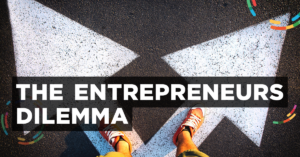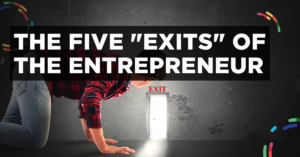Entrepreneurs don’t all have the impact they strive for.
The kind of impact that changes your life, your customer’s life, and the lives of your employees. It’s what you dreamed of when you first started your business and thought about what it would be like to have total freedom.
Unfortunately reality sets in fast.
→ You don’t have enough money in the bank.
→ Your business can’t survive without you.
→ You don’t have enough customers buying.
Freedom slips away as you spend long nights trying to figure out how to be profitable, make your business run without your face as, essentially, its logo, and make a predictable income.
These 3 traps are so common in fact, that the entrepreneurs who fall prey to them become fairly recognizable with a quick glance.
At T&C 2020, Roland Frasier talked about these 3 different kinds of entrepreneurs that are unsuccessful when trying to scale their business. With decades of experience starting, acquiring, and selling dozens of businesses, Roland has seen it all. He knows how to spot a scalable business from one that’s just never going to make it.
And for him, it all comes down to whether or not the business owners can avoid becoming one of these three types of entrepreneurs.
The Three Types of Entrepreneurs
Type #1: The Toothless Chihuahua
Chihuahuas are fearless. They’ll run right up to a German Shepherd and bravely bark into their ear. As a bystander, you can laugh at the Chihuahua’s might. They think they have a chance, but little do they know it all comes down to the German Shepherd’s patience. The Chihuahua is all bark and no bite.
Businesses that don’t have proper margins are toothless Chihuahuas.
They don’t have bankable profits which means the entrepreneur is just scraping by. Sometimes we see these “ballers-on-budgets” renting private jets and fancy cars by the hour, trying to pretend they’re the German Shepherd.
Other times we see business owners like Ryan Deiss, who don’t care about posing in front of a private jet for their Instagram and instead refuse to take money out of their business. As long as they don’t take anything out of the business, it will have the highest chance of succeeding—right?
“For the longest time I was content growing a business, but I wasn’t taking money out of the company. I was always stressed out and didn’t feel like I had a lot of security. Roland came in and had us double the amount we were taking out of the company. I was so scared, but it ended up working out just fine.” says Ryan.
If you don’t have Roland Frasier telling you everything will work out, how do you muster the courage to pay yourself?
We’ll talk about that after we go through the two other types of entrepreneurs.
Type #2: The Dancing Bear
Dancing bears are incredibly entertaining. When they walk on stage, everybody looks, applauds, and can’t wait to hear what they have to say. They pull views on social media and they turn prospects into customers. Aspiring entrepreneurs spend a lot of time trying to be like them and suddenly realize—it’s not what they’d hoped for.
As the dancing bear, your business can’t survive without you.
Since your face and name are tied to the business, stopping your choreography requires a full rebrand and potentially losing your edge in the marketplace. This business doesn’t have transferable value because without you, there is no business.
And that’s a problem. Tony Robbins realized that he was a dancing bear years ago. He knew that as long as he was on stage performing, he could make money. But what happened when he stopped putting the mic on? This sparked him to help others create wealth by investing in a fund that he created, which also helped him generate wealth.
He had to de-guru-fy his business for it to survive when he didn’t want to be the face of it in the future. If you have transferable value, you have power.
Type #3: The Hamster on a Wheel
How often do you feel like your to-do list just doesn’t end? As soon as you cross off one task, three more pop up in its place. At the end of the day, you rarely feel satisfied with what you’ve done because there is so much more to do. This is the danger zone where burnout thrives and where we never want to see you go.
The hamster on the wheel has no choice but to stay on that wheel because they don’t have predictable sales.
They have to keep chasing their next payday and replacing the sales they made last month. If they stop running, their sales dwindle down to zero and they can’t pay their team, afford their expenses, or pay themselves.
It’s easy to become the hamster when your business is first starting out. You’re happy to get any sale that you can get. But, you have to turn that sale into more than just another sale. At Scalable.co, we call this building a predictable selling system. It’s a system that you can turn on and off anytime you need to increase your revenue.
We call them systems because they can be replicated with different products, and still bring in measurable, predictable sales shortly after launch. It’s how we run our businesses so we never have to even see the wheel. We know what’s coming our way before we’ve even officially launched our next product.
How do you stop being one of these entrepreneurs (or worse, being more than one of them)?
By implementing a system designed specifically to overcome these 3 entrepreneurial traps.
Scalable Impact Is Your Ticket To Freedom
When you dreamt of entrepreneurship, you were thinking of the Scalable Impact Framework. You just didn’t realize that’s what you were thinking of.
→ You imagined cashing money from your business’s account to your personal account (Bankable Profits)
→ You loved the idea of your business making money while you were vacationing with your family (Transferable Value)
→ You imagined freedom over your schedule and getting to work fewer hours to make more money (Predictable Sales)
You wanted to scale…and have a good time doing it.
Here’s what the Scalable Impact Framework looks like:
To properly scale (and avoid the pitfalls we talked about above) you need predictable sales, bankable profits, and transferable value. These all work together to make your business into a powerhouse of momentum with the optionality to exit or sell just part of your business in the future.
Predictable Sales + Bankable Profits = Momentum
You can’t get momentum without predictable sales. But, you also can’t get momentum if you don’t have money to put back into the growth of your business (and put food on the table for yourself and your team).
Without momentum, your business doesn’t move forward. It sits stagnant, and no matter how hard you try to push it—it just doesn’t budge.
Bankable Profits + Transferable Value = Optionality
Your business needs to be profitable to have the option of exiting or selling a specific piece of it. Yet, without transferable value, nobody can buy it. If your business relies on you showing your face to bring in profits, it’s useless to anybody else (that isn’t your identical twin).
To have optionality in the future, you need to prove your business is a success now and in the future (even after you’ve exited).
Transferable Value + Predictable Sales = Power
Once you can prove your business doesn’t need you to act as the dancing bear to make money and that you have predictable sales coming your way…you’ve hit a new level of entrepreneurship. This is when you’ve really tapped into the freedom you initially sought all those years ago when this was just a dream in your mind.
True power comes from knowing you can sell your business (or part of it) and being able to prove that money is going to funnel in. That’s when you get to pick and choose who acquires you and for how much. It’s like stepping into Level 10 of entrepreneurship.
The Scalable Impact Framework is at work in our business and all those we work with. We make sure the entrepreneurs in our circle aren’t getting fooled into becoming a toothless Chihuahua, a dancing bear, or a hamster on a wheel. Take it from us—you don’t need to go down that route. You can avoid it entirely by learning and implementing the Scalable Impact Framework to ensure you’re building a business with a long future.
See if your business is ready to scale now, or if you need to fix a few things first, by getting your ScalABILITY Score. We’ll ask you questions like what stage your company is in now, what the demand for your products and services is, and what your goals are to give you a real-time read on how scalable your business is today.
Get your ScalABILITY Score here.


